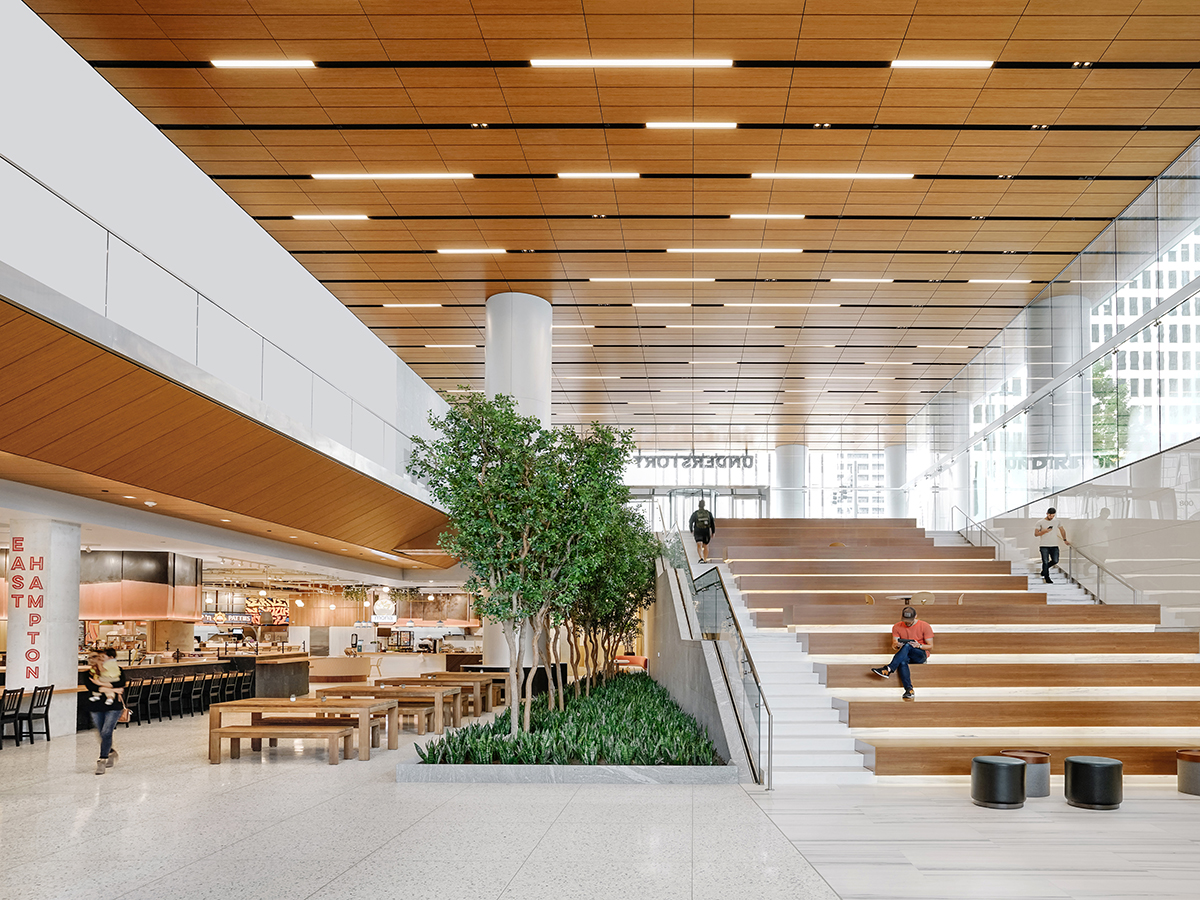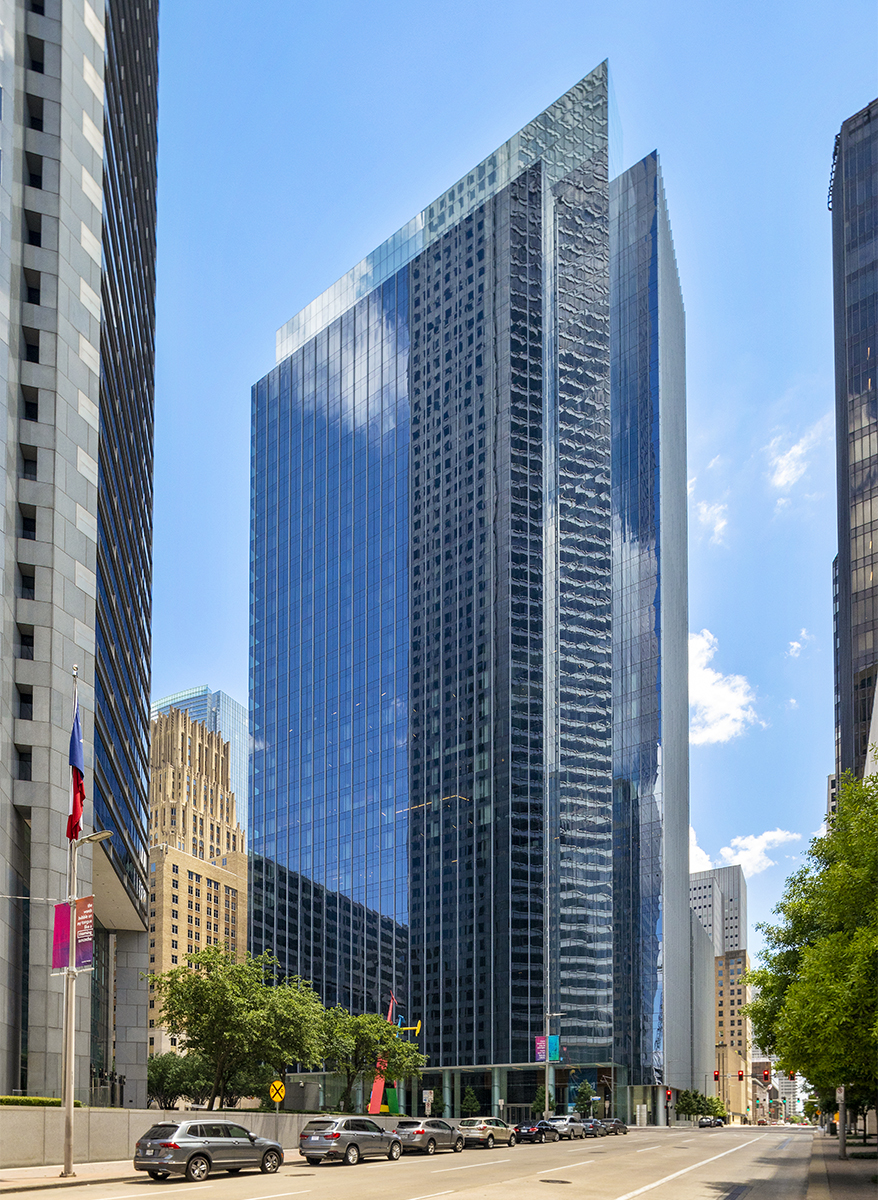Sustainable Office Design Case Study
Skanska raises the bar on green buildings with Houston's first LEED Platinum office property.
Global development and construction firm Skanska has raised the bar significantly on green office buildings with its Bank of America Tower at 800 Capitol Street in Downtown Houston. Designed to earn ENERGY STAR, the 775,000-square-foot mixed use project is also the first commercial office development in Houston to achieve LEED Platinum under the USGBC’s current Core & Shell certification program. In fact, it is the largest LEED v4 Platinum Core & Shell project in the world.

Amenity spaces help Bank of America Tower tenants attract and retain top talent. Image courtesy of Skanska
Skanska targets a minimum of LEED Gold at all its U.S. commercial development projects, with many achieving LEED Platinum, according to Matt Damborsky, executive vice president for Skanska Commercial Development in Houston. “At Bank of America Tower we saw an opportunity to be one of the first projects in the world to test the new LEED v4 standard and to pursue Platinum while doing so,” Damborsky said.
Rising 35 stories, Bank of America Tower uses 32 percent less energy than typical baseline facilities. The LEED Platinum development’s sustainable features include the 24,000-square-foot SkyPark, the first and largest green roof in Downtown Houston that is open to all building tenants; a 50,000-gallon rainwater collection system for reuse in landscape irrigation and restrooms; secured bicycle storage room with access to lockers and showers; one block proximity to three MetroRail stations; 90 percent access to daylight and views for tenants; a high-performance façade that significantly reduces solar heat gain; an energy recovery wheel to precondition fresh air intake; and district cooling to provide chilled water throughout the facility, lower cooling costs and unlimited service capacity to tenants.
Reaction from the marketplace has been positive. In Houston, employers are looking for innovative ways to connect with a new generation of employees. Green amenities outside the traditional office, such as SkyPark, are especially in demand and a powerful way to attract and retain talent.
“Also, tenants are placing a premium on sustainability and, as a result, are beginning to see a number of benefits, including the establishment of a healthier work environment and better overall energy efficiency and higher cost savings,” Damborsky added.

Amenity spaces help Bank of America Tower tenants attract and retain top talent. Image courtesy of Skanska
Collective Effort

Rising 35 stories, Bank of America Tower was designed by Gensler with a high-performance facade that significantly reduces solar heat gain and contributes to its LEED Platinum certification. Image courtesy of Skanska
All Bank of America Tower tenants receive a manual with detailed standards and requirements for making improvements to tenant spaces. According to Damborsky, this includes guidance around material selection, lighting efficiency and plug loads to ensure that the building operates to the efficiency and sustainability criteria that it was designed to achieve. “In addition, our on-site property management and building operations team is trained to ensure that the overall operations of the building are functioning as designed,” said Damborsky.
Bank of America Tower is currently 90 percent leased. Originally called Capitol Tower, the property was renamed for anchor tenant Bank of America, which occupies a total of 210,000 square feet spanning six-and-a-half floors of the office tower that was designed by architecture firm Gensler.
Gensler’s simple building exterior expresses a modern yet timeless aesthetic. “The unique curtain wall design was an important element to the building’s overall sustainable strategy,” said Kristopher Stuart, principal and design director in Gensler’s Houston office. “Through testing and research with solar and energy modeling, computer modeling and physical mockups we were able to achieve targeted performance with a curtain wall system that allows maximum interior visibility, no visual obstructions and maximum planning flexibility for the market-driven office building.”

Bank of America Tower also scored LEED Location & Transportation points due to its enviable location within one block of three MetroRail stations. Image courtesy of Skanska
Gensler’s design scope included the core and shell building architecture and design of the common spaces at the ground and tunnel level but not the individual retail kiosks in the tunnel level. The highly leasable floor plate includes large, open and bright spaces that are efficient and flexible. Gensler was also engaged to design tenant spaces but under separate contracts.
The tower was also designed to be a source of civic and tenant pride. “From top to bottom, Bank of America Tower was designed for people,” said Stuart. “The design of the two-level, open-air building lobby and tunnel-level pedestrian space have a warmth that attracts people, rather than serving as a pass through or series of common spaces. The materiality of warm wood and vibrant stone combines to make tenants and pedestrians feel comfortable.”
The goal was to create an environment that encouraged pedestrians and visitors to stay and linger and inspire tenants to come out of their offices to collaborate, meet and socialize. Stuart adds, “If we had gotten that component wrong, the whole project would have been different.”







You must be logged in to post a comment.